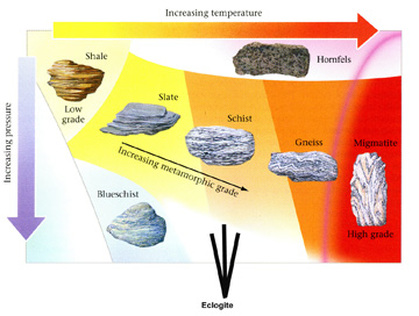This is a continuous process given more temperatures and pressure the rock may melt completely and would eventually turn into and igneous rock that will get eroded and become limestone again.
Can gniess turn into marble.
With continued metamorphism these crystal seeds grow while any clay deposits in the limestone transform into silicate structures such as mica.
When subjected to extreme heat and pressure it gets converted into marble a metamorphic rock.
Marble is a metamorphic rock that forms when limestone is subjected to the heat and pressure of metamorphism.
Because marble is a fairly soft material only a three on the mohs hardness scale it is easy to cut and carve.
When granite is subjected to intense heat and pressure it changes into a metamorphic rock called gneiss.
Limestone can change into marble shale and mudstones into slate and igneous rocks like granite can turn into gneiss.
Thicker veins of large grained minerals form in it unlike the more evenly layered appearance of schist.
Basalt is the most common mafic protolith.
Process that can turn granite into sediment.
Mafic mafic protoliths and the metamorphic rocks they become are high in magnesium and iron relative to silicon.
Regional metamorphism can transform shale into slate then phyllite then schist and finally into gneiss.
The extent to which the rocks are changed depends on.
Limestone a sedimentary rock will change into the metamorphic rock marble if the right conditions are met.
Under extreme temperature and pressure it could become a mylonite basically a really stretched out gneiss.
The most common path begins with shale which is a sedimentary rock.
Process that makes magma deep inside the earth turn into granite magma into igneous rock.
Obsidian has the same composition as granite only it is glass instead of crystals.
Whether they are exposed to heat pressure or both.
During this transformation clay particles in shale transform into micas and increase in size.
With still more metamorphism gneisses can turn to migmatite and then totally recrystallize into granite.
Process that can turn gneiss into magma metamorphic rock into magma weathering and erosion.
It can turn into mafic metamorphic rocks such as greenschist and amphibolites with chlorite actinolite biotite hornblende or plagioclase in them depending on metamorphic grade.
Gneiss can form in several different ways.
Whether they are forced to change shape.
Under metamorphic conditions it would probably crystallize and turn into a gneiss which is what granites metamorphose to.
Process that can turn limestone into marble sedimentary rock to metamorphic rock.
You can see that unlike schist which is more strongly aligned gneiss doesn t fracture along the planes of the mineral streaks.









